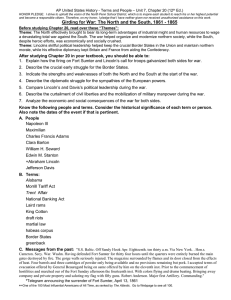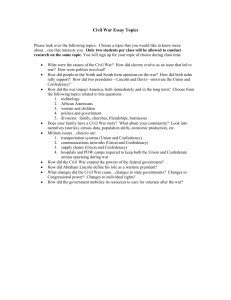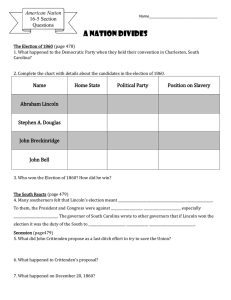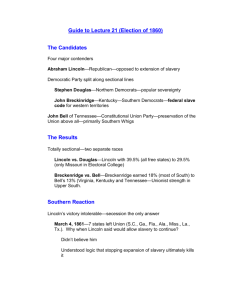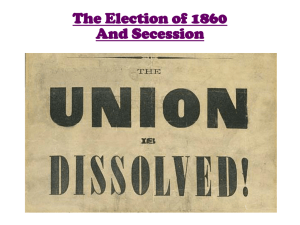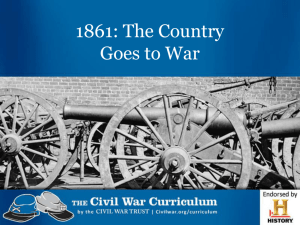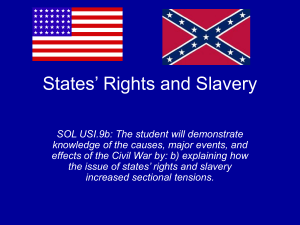Mur_Con15
advertisement
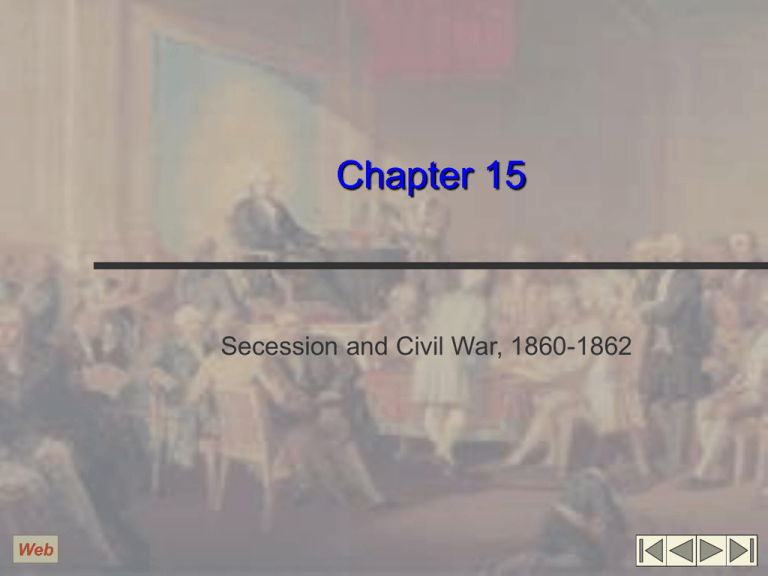
Chapter 15 Secession and Civil War, 1860-1862 Web The Election of 1860 Democrats endorse popular sovereignty rather than an overtly pro-slavery platform Nominated Stephen Douglas Southern Rights Democratic Party bolted convention Nominated John C. Breckinridge Constitutional Union Party coalition of former Whigs Nominated John Bell Republican platform pledged exclusion of slavery from territories and other issues to appeal to different groups in North Nominated Abraham Lincoln Southerners saw Lincoln’s nomination as threat to slavery Lincoln won with 40% of popular vote The Secession of the Lower South Lincoln’s election sparked fears of a total assault on slavery Brought to fore southern thinking on the nature of the Union Saw as a voluntary compact Any state could leave whenever it wished Seven southern states had seceded by Lincoln’s inauguration Most northerners saw secession as unconstitutional and treasonable Failed attempts at compromise through late 1860 and earl 1861 Crittendon Compromise most notable ©2004 Wadsworth, a division of Thomson Learning, Inc. Thomson Learning ™ is a trademark used herein under license. Election of 1860 and Southern Secession Establishment of the Confederacy Constitution protected slavery in both the states and the territories Strengthened state sovereignty and limited governmental power Limited president to a single six-year term Sought to encourage upper South to secede Fort Sumter and First Shots of Civil War Confederates demanded federal withdrawal from fort in Charleston Harbor Federal forces hung on, but ran short on supplies Reaching crisis point when Lincoln was inaugurated in March 1861 Decided to send unarmed supply ships to fort Confederacy attacked fort before supplies could arrive Started what became the Civil War in April 1861 Immediate Reaction to War, North and South In North, Lincoln issued immediate call for volunteers Response was overwhelmingly In South, public responded enthusiastically Virginia, Arkansas, Tennessee, and North Carolina seceded Border states torn by divided sentiments Only Delaware remained firmly in the Union Maryland, Kentucky, and Missouri contested ground West Virginia created in 1863 Anti-slave in orientation, loyal to Union Comparing Northern and Southern Readiness for War North superior in almost every category of measurement Higher population Larger military manpower Almost all of nation’s industrial capacity and registered shipping South did have some advantage Greater military experience among its commanders Rural nature of southern life provided civilians with valuable skills Had begun preparing for war earlier than the North Had home-front advantage in defending own territory Higher morale and deeper commitment to cause of war Mobilizing for War, North and South Military forces largely volunteers on both sides New Military technology utilized Infantry rifle was most lethal weapon of war Infantry tactics gradually adjusted to new weapon General technology shaped course/outcome of war Railroad and steamship transported supplies and soldiers Telegraph provided for better communication War generally financed through a number of methods Mobilizing for War, North and South (cont.) Confederacy experienced problems funding the war Slow to raise taxes Little public capital available for purchase of war bonds Largely relied on limited issue of treasury notes Instituted comprehensive tax program in 1863 – Generated significant public opposition – Too little, too late to really solve war funding problem Union more successful in funding war Two-thirds of funding came from war bonds Other funding sources were taxes and treasury note issues International The Side of the Civil War South employed “King Cotton diplomacy” Hoped to win British support through lure of cotton exports Exports complicated by northern blockade of southern ports South legitimized by keeping 1861 cotton crop home Blockade seriously crippled southern economy Confederacy sought international recognition Largely unsuccessful Trent Affair illustrated frustration of Confederate diplomacy Confederate naval strategy focused on breaking Union blockade Commissioned two commerce raiders from British shipbuilders Naval technology advanced both sides’ capabilities Monitor v. Virginia, 1862 Initial Military Encounters Union employed Anaconda Plan to squeeze Confederacy into submission Virginia would be key battleground, especially after Richmond became capital of Confederacy Battle of Manassas (Bull Run) 1861 String of Union naval victories in 1861 and 1852 Captured New Orleans in April 1862 Combined Union naval/ground operations important victories Forts Henry and Donelson Pitched battles throughout 1862 Battle of Shiloh Battle of Vicksburg Seven Day’s battles Second Battle of Bull Run Principal Military Campaigns of the Civil War Web ©2004 Wadsworth, a division of Thomson Learning, Inc. Thomson Learning™ is a trademark used herein under license.
